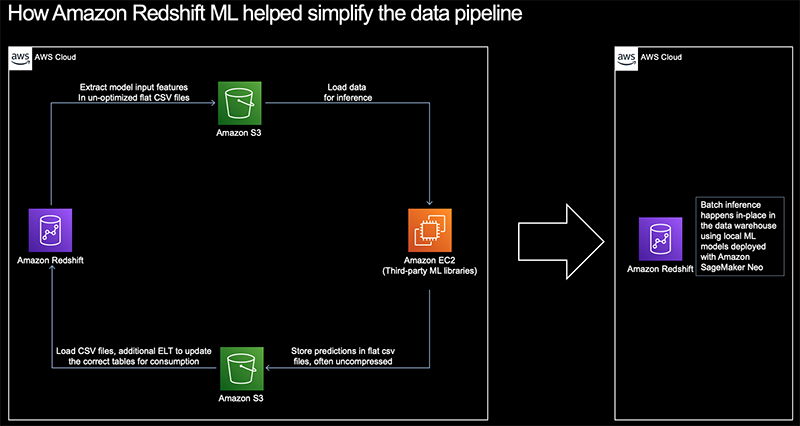AWS Big Data Blog
Category: Analytics
Access Amazon Location Service from Amazon Redshift
Organizations typically store business and customer data in databases like Amazon Relational Database Service (Amazon RDS) and Amazon Redshift, and often want to enrich this data by integrating with external services. One such enrichment is to add spatial attributes such as location coordinates for an address. With the introduction of Amazon Location Service, you now […]
Synchronize and control your Amazon Redshift clusters maintenance windows
Amazon Redshift is a data warehouse that can expand to exabyte-scale. Today, tens of thousands of AWS customers (including NTT DOCOMO, Finra, and Johnson & Johnson) use Amazon Redshift to run mission-critical business intelligence dashboards, analyze real-time streaming data, and run predictive analytics jobs. Amazon Redshift powers analytical workloads for Fortune 500 companies, startups, and […]
Accelerate your data warehouse migration to Amazon Redshift – Part 2
This is the second post in a multi-part series. We’re excited to shared dozens of new features to automate your schema conversion; preserve your investment in existing scripts, reports, and applications; accelerate query performance; and potentially reduce your overall cost to migrate to Amazon Redshift. Check out all posts in this series: Accelerate your data […]
Establish private connectivity between Amazon QuickSight and Snowflake using AWS PrivateLink
October 2023: This post was reviewed and updated to include SPICE setup Amazon QuickSight is a scalable, serverless, embeddable, machine learning-powered business intelligence (BI) service built for the cloud. QuickSight lets you easily create and publish interactive BI dashboards that include Machine Learning-powered insights. QuickSight dashboards can be accessed from any device, and seamlessly embedded […]
Secure multi-tenant data ingestion pipelines with Amazon Kinesis Data Streams and Kinesis Data Analytics for Apache Flink
August 30, 2023: Amazon Kinesis Data Analytics has been renamed to Amazon Managed Service for Apache Flink. Read the announcement in the AWS News Blog and learn more. When designing multi-tenant streaming ingestion pipelines, there are myriad ways to design and build your streaming solution, each with its own set of trade-offs. The first decision […]
Creating dashboards quickly on Microsoft Power BI using Amazon Athena
April 2024: This post was reviewed for accuracy. Amazon Athena is an interactive query service that makes it easy to analyze data in a data lake using standard SQL. One of the key elements of Athena is that you only pay for the queries you run. This is an attractive feature because there is no hardware to set […]
Query a Teradata database using Amazon Athena Federated Query and join with data in your Amazon S3 data lake
If you use data lakes in Amazon Simple Storage Service (Amazon S3) and use Teradata as your transactional data store, you may need to join the data in your data lake with Teradata in the cloud, Teradata running on Amazon Elastic Compute Cloud (Amazon EC2), or with an on-premises Teradata database, for example to build […]
Query an Apache Hudi dataset in an Amazon S3 data lake with Amazon Athena part 1: Read-optimized queries
July 2023: This post was reviewed for accuracy. On July 16, 2021, Amazon Athena upgraded its Apache Hudi integration with new features and support for Hudi’s latest 0.8.0 release. Hudi is an open-source storage management framework that provides incremental data processing primitives for Hadoop-compatible data lakes. This upgraded integration adds the latest community improvements to […]
How Jobcase is using Amazon Redshift ML to recommend job search content at scale
This post is co-written with Clay Martin and Ajay Joshi from Jobcase as the lead authors. Jobcase is an online community dedicated to empowering and advocating for the world’s workers. We’re the third-largest destination for job search in the United States, and connect millions of Jobcasers to relevant job opportunities, companies, and other resources on […]
Query Snowflake using Athena Federated Query and join with data in your Amazon S3 data lake
This post was last reviewed and updated July, 2022 with updates in Athena federation connector. If you use data lakes in Amazon Simple Storage Service (Amazon S3) and use Snowflake as your data warehouse solution, you may need to join your data in your data lake with Snowflake. For example, you may want to build […]








